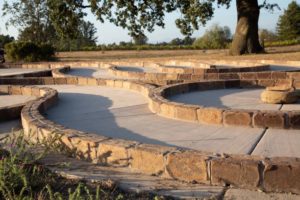Labyrinths can be found all over the world in civilizations ranging from the Egyptians to the ancient Romans. The construction of a labyrinth consists of an outer path that moves in a circular motion to a center point, then back out again.
The practice of walking a labyrinth is a method of walking meditation. Around the world, they are used to reduce stress, find harmony and lower anxiety. At Earle Baum Center, the creation of the labyrinth incorporates all of its uses, while adding a significant enhancement: raised edges to accommodate people with disabilities.
“Our hope is to make this labyrinth accessible to those who use a white cane, guide dog, walker or wheelchair to travel,” said Patricia Jefferson, vision rehabilitation instructor at Earle Baum Center. “Its smooth concrete paths are 39 inches wide with 4 inches high brick curbs on each side of the path to help guide visitors safely.”
Created in 2018, the labyrinth at Earle Baum Center has been a welcomed addition to the property. It offers clients, family members and visitors a chance to be in nature while also calming their minds and bodies. The labyrinth features prominently in the center’s mobility and orientation classes.
The labyrinth was the brainchild of Patricia Jefferson and funded by a generous donation by an anonymous donor. At the entrance to the structure, there is a commemorative plaque with a description in braille. Per Jefferson’s design, the labyrinth is in the shape of a Baltic Wheel design, and is formed by two paths; one short path that takes about a minute to complete, and a second path which takes a few minutes. In the center of the labyrinth, there is a peace pole to help orient the walker. The labyrinth is open to the public during opening hours at Earle Baum Center. Please contact us for more information or to plan your visit.


